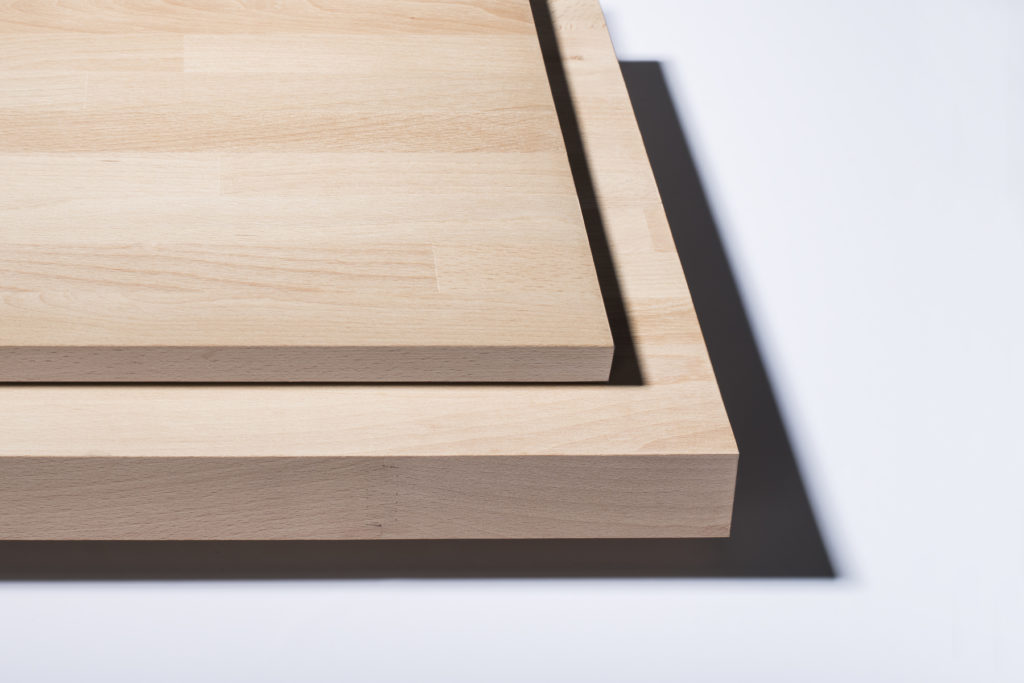Finger jointed panels have become popular in the last few years due to their big advantages over other joints like the box joint, bridle joint or butt joint. Finger joint panels are basically single-layer panels built from the best natural wood.
More specifically, these panels are a woodworking joint that’s made by cutting a pair of complementary, interlocking profiles into two wood pieces to be glued together. The cross-section of the joints looks like the interlocking of fingers of two hands. Therefore, it’s called the “finger joint”. The sides of the two profiles expand the surface area due to gluing, ensuring a stronger bond than a butt joint.
Technical Features of Finger Jointed Panels
Technical features of finger jointed panels vary based on the type of finger joint. Here’re some examples.
For steamed, unsteamed or oak beech, ash, European Maple, BER, iroko and walnut type:
- Thickness: 19-26-31-40 and 50mm.
- Length: 4000mm and 2000mm.
- Width of Lamellas: 20mm and 40mm (+/- 2mm).
- Width of Panels: 950mm and 650mm.
For hevea:
- Thickness: 18-22-33-44 and 56mm.
- Length: 4500mm.
- Width of Lamellas: 40mm (+/- 2mm).
- Width of Panels: 1100mm.
- Wooden Poles: Length of 4000mm, sections of 70 x 70mm or 90 x 90mm.
For American White oak:
- Average Weight: 769kg/m3.
- Modulus Elasticity: Average 12,600 Mpa.
- Compression Strength: Average 52 Mpa.
- Flexural Strength: Average 106 Mpa.
- Hardness: Medium to high.
Reasons Finger Jointed Panels are Popular in Construction Industry
Finger jointed panels are mostly used for their exceptional strength and top quality. At the same time, they take care of lowering waste, which in turn, helps the businesses to lower the cost of the raw materials.
There’re other major benefits for which it’s becoming popular in the construction industry day by day. Let’s discuss them.

Excellent Strength
Since they are produced by merging small wood pieces with a larger surface area to be glued together, finger jointed panels provide more strength than other common lumber. This is extremely helpful for the companies because they can use such panels to carry heavy weight.
Decrease Waste
The smaller wooden pieces usually would have been thrown away because they are not that much useful. But as already said, finger jointed panels are made by joining smaller wood pieces together. Therefore, less wood is wasted while manufacturing.
Cost-Effective
Since there is less reduction in waste, it helps the companies lower their cost. Not to mention, it is eco-friendly too.
High Stability
Regardless of the length of finger jointed panels, they provide significant stability. They make sure there is no twisting or warping since they are produced by joining smaller pieces of wood together with glue.
Appealing Look
Finger jointed panels come out more appealing than other conventional joints. They lessen or sometimes even eradicated unlikeable elements like discoloration. It is only possible for the way they are made.
Better Nailing Surface
Finger jointed panels provide better and more nailing surface area. Because there is not so much inconsistency at the surface edges.
For these significant advantages, use a finger jointed panels.The first choice for most construction companies.
Finger Joint Disadvantages
However, there are a few disadvantages also come with this design. For example, it is difficult to achieve a smoother surface and sometimes, they can be out of shape if not joined properly.
Another issue is the finger joint wood can be affected by water because it is not a water-obstruction wood. So, they are not so durable.
Applications of Finger Joint
Since finger joints are great sturdy and stronger, they are ideal for premium-quality furniture. But apart from that, they have a large area of applications. For example,
- Finger joint lumber where a scarfed or tapered finger joint is commonly used to make long pieces of lumber using solid boards.
- Parquet flooring.
- Doors.
- Moulding or trim.
- Table tops.
- Worktops.
- Floor boards.
- Solid wood interior panels.
- Home staging.
- Construction beams.
Conclusion
Finger joints are widely used due to their high stability, strength and better appearance. The finished products are much strong and can retain their shape. That’s why construction industries like furniture or others prefer finger jointed panels to make products.






